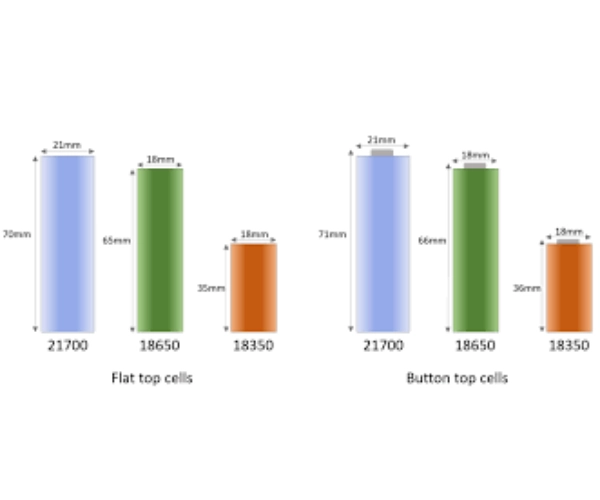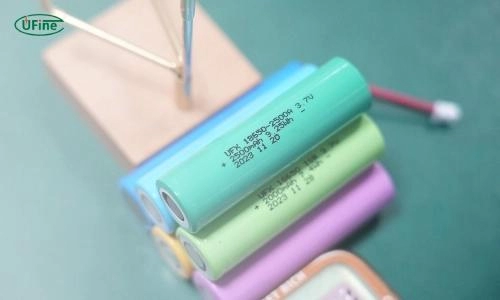In the realm of rechargeable batteries, the 18650 battery type is widely used, with flat top and button top designs being two of the most common variations. Choosing between flat top and button top 18650 batteries can be challenging, so this guide breaks down the key differences, advantages, disadvantages, and help you select the best battery for your device, ensuring you make the right choice.
Part 1: What is an 18650 Flat Top Battery and Why Choose It?
An 18650 flat top battery is a type of cylindrical lithium-ion battery characterized by its flat positive terminal. Unlike button top batteries, it does not have a protruding button on the positive end, allowing for a more compact design. This flat top design makes it well-suited for devices where battery compartment space is limited.
Advantages and Disadvantages of 18650 Flat Top Batteries
Advantages:
- Compact Size: With no protruding button, flat top 18650 batteries are more compact, making them ideal for devices with space-constrained battery compartments.
- Versatility: Flat top batteries are compatible with a wide range of devices that require 18650 batteries, including flashlights, vaporizers, and power tools.
- Enhanced Safety: The flat design reduces the risk of accidental short circuits during insertion or removal.
Disadvantages:
- Limited Compatibility: Some devices, particularly those designed for button top batteries, may not be fully compatible with the flat top variant. The absence of a button can sometimes result in poor electrical contact.
- Lower Capacity: Flat top batteries are often slightly smaller than button top batteries, which can result in a slightly lower capacity and shorter run times in certain applications.
Part 2: What is an 18650 Button Top Battery and Why Choose It?
As the name implies, 18650 button top batteries feature a protruding button on the positive terminal. This design, often referred to as a raised positive terminal, is commonly used in devices that require this configuration to maintain proper contact.
Advantages and Disadvantages of 18650 Button Top Batteries
Advantages:
- Compatibility: Button top batteries are specifically designed to fit devices designed for this battery type. They ensure proper electrical connection, especially in devices with spring-loaded battery compartments.
- Higher Capacity: Button top batteries often have a higher capacity than flat top batteries, meaning they can provide longer run times, especially in devices that require more power.
Disadvantages:
- Size Limitations: The protruding button makes button top batteries slightly larger than flat top batteries. This can be a problem in devices where battery compartment space is limited.
- Potential Short Circuit Risk: The raised button can short-circuit if it contacts conductive materials during storage.
Part 3: Key Differences Between Flat Top and Button Top 18650 Batteries
Both flat top and button top 18650 batteries offer unique features that can impact device compatibility and performance.
Size:
- Flat Top: The positive terminal is completely flat, creating a smooth, even surface with the battery top.
- Button Top: The positive terminal protrudes slightly, forming a distinct button-like shape on the battery top.
Compatibility:
- Flat Top: These batteries are often used in devices with spring-loaded or sliding battery compartments that can accommodate a flat terminal.
- Button Top: Users typically choose button top batteries for devices with fixed or rigid battery compartments specifically designed to accept a protruding terminal.
Contact Surface:
- Flat Top: The flat design of the positive terminal can provide a larger contact surface area in some devices, potentially enhancing conductivity.
- Button Top: The protruding button ensures direct contact with the battery terminal in devices with recessed or restricted battery compartments.
Device Suitability:
- Flat Top: Ideal for devices where space is limited, as the flat top design allows for greater design flexibility.
- Button Top: Best suited for devices requiring a secure and stable connection, often found in gadgets relying on spring-loaded or fixed battery compartments.
For more in-depth information on battery types, check out our guide to lithium-ion batteries.
Flat Top vs. Raised Top 18650 Batteries: A Comprehensive Guide
When selecting 18650 batteries, understanding the differences between flat top and button top designs is crucial for device compatibility. This guide explores the unique characteristics of each battery type to help you make an informed decision based on your needs.
Part 1: Battery Type Overview
Flat Top 18650 Batteries
Flat top batteries have a flat positive terminal, making them compatible with devices that use flat contacts or spring-loaded battery compartments. Their compact design allows them to fit into more spacious or open battery compartments, making them suitable for a wide range of devices, including flashlights, laptops, and electric vehicles.
Button Top 18650 Batteries
Button top batteries have a positive terminal that protrudes, resembling a small button. They are often designed for devices that require a specific type of battery compartment, often with a fixed or specialized design. Button top batteries often have higher capacity and longer run times, making them ideal for high-power devices such as vaping devices.
Part 2: Key Features
Compatibility
- Flat Top Batteries: Suitable for devices using flat contacts or spring-loaded battery compartments.
- Button Top Batteries: Designed for devices with fixed or specialized battery compartments that require a protruding positive terminal.
Handling
- Flat Top Batteries: Easier to handle and insert into devices with spacious or open battery compartments due to their flat profile.
- Button Top Batteries: Better suited for devices requiring a protruding terminal for alignment.
Applications
- Flat Top Batteries: These batteries are versatile and suitable for a variety of devices, including flashlights, laptops, and electric vehicles.
- Button Top Batteries: Preferred for devices that require a protruding positive terminal, such as certain vaping devices.
Design
- Flat Top Batteries: Offer a sleek and uniform appearance when installed in compatible devices.
- Button Top Batteries: The button-shaped terminal provides a distinct look that can enhance the aesthetics of compatible devices.
Size Comparison
| Aspect | Flat Top 18650 Battery | Button Top 18650 Battery |
|---|---|---|
| Terminal Type | Flat Positive Terminal | Protruding Button-Shaped Terminal |
| Compatibility | Designed for Flat Contacts or Spring-Loaded Compartments | Best for Fixed or Dedicated Compartments |
| Capacity | Compact Design, Potentially Slightly Lower Capacity | Often Offers Higher Capacity for Extended Run Time |
| Short Circuit Risk | Lower Risk Due to Flat Design | Higher Risk if Exposed Button Top is Improperly Stored when Improperly Stored |
| Applications | Versatile (Flashlights, Laptops, etc.) | Preferred for High-Power Devices (Vaping Devices) |
Part 3: Considerations for Choosing Flat Top and Button Top Batteries
1. Device Compatibility
Before making a purchase, check whether your device requires a specific type of battery. Some devices have explicit requirements or physical limitations regarding the battery type, allowing for only flat top or button top batteries.
2. Space Constraints
Assess the space within your device’s battery compartment. If space is limited, a flat top battery may be more suitable. Conversely, if the device has sufficient space, a high-capacity button top battery would be a better choice.
3. Power Requirements
Consider the power demands of your device. If the device has high power consumption, such as an electric vehicle or power tool, a high-capacity button top battery is the better choice. For devices with lower power needs, a flat top battery may suffice.
4. Safety Considerations
Safety is an important factor when choosing between flat top and button top batteries. Flat top batteries have a lower risk of accidental short-circuiting, while button top batteries have a higher risk if improperly stored.
Part 4: Conclusion
When choosing between flat top and button top 18650 batteries, it is essential to consider the specific requirements of your device. Flat top batteries offer versatility and a compact design, making them suitable for a wide range of applications. Button top batteries, while providing higher capacity and longer run times, are ideal for devices that require a specific battery compartment. By comprehensively assessing compatibility, space, power needs, and safety, you can select the best battery for your device.
Part 5: Understanding Power Needs of Different Devices
Power requirements are a critical factor in choosing between flat top or button top batteries. High-power devices like electric vehicles or power tools require button top batteries with higher capacities to ensure extended run times. In contrast, low-power devices are better suited for flat top batteries, which provide an efficient and compact power solution.
18650 Batteries: Flat Top vs. Button Top
When choosing between flat top and button top 18650 batteries, it’s important to understand the differences between them and how they affect your device’s performance. Here’s a comprehensive guide to help you choose the right battery.
Flat Top vs. Button Top: What’s the Difference?
The main difference between flat top and button top 18650 batteries lies in the terminal design of the positive end of the battery. Button top batteries have a small protruding button on the positive end, while flat top batteries have a flat end.
- Flat Top 18650 Batteries: These batteries are often preferred for devices with spring-loaded battery compartments. Their compact design makes them ideal for low-power devices like flashlights, as the flat terminal ensures a secure fit.
- Button Top 18650 Batteries: These batteries feature a small, button-like protrusion that ensures a reliable connection in devices with fixed terminals or specific contact points, such as some high-powered devices and vaping devices.
Which Should You Choose for Your Device?
Selecting the right type of 18650 battery for your device is crucial for optimal performance. Here’s how to choose the right one:
- For Low-Power Devices: If you’re using a device that requires lower power, such as a handheld flashlight, a flat top 18650 battery is often the best choice due to its compact design and compatibility with spring-loaded compartments.
- For High-Power Devices: If you’re using a high-power device like a vaping device, button top 18650 batteries are often preferred because they tend to offer higher capacity and are compatible with devices that have fixed terminals or require more power.
Understanding your device’s power requirements will help you choose the correct battery type.
Frequently Asked Questions (FAQ)
Which 18650 battery type is better for vaping: flat top or button top?
Button top 18650 batteries are generally considered better for vaping because they tend to offer higher capacity and are better suited for the high-power demands of vaping.
Can I use a flat top battery in a device that requires a button top battery?
No, flat top batteries are not suitable for devices that require a protruding button. The lack of a button prevents proper contact, potentially causing performance issues.
How do I know which type of 18650 battery is compatible with my device?
Check your device’s manual or look for physical indicators, such as spring-loaded compartments or fixed terminals, to ensure compatibility with the correct type of battery.
Are button top 18650 batteries safer than flat top 18650 batteries?
Both flat top and button top batteries are safe when used correctly. However, button top batteries can pose a short-circuit risk if stored improperly due to the exposed positive terminal. Always follow safety guidelines for battery storage and handling.
Related Articles
- Battery Storage Tips
Learn how to properly store your batteries to extend their lifespan and ensure safety. Discover effective tips for organization and preventing damage. - Understanding Lipo Battery Storage Voltage
Understand the importance of storing your Lipo batteries at the correct voltage to prolong their lifespan. Learn the ideal voltage range for optimal performance. - Lithium Battery Cost Breakdown: Factors Behind the Price
Explore the factors that influence the price of lithium batteries, including supply and demand, raw materials, and industry trends. - Liquid Metal vs. Lithium Batteries: A Comparison
Compare the characteristics, applications, and future prospects of liquid metal batteries and lithium batteries in this detailed analysis. - Lipo Batteries: A Complete Guide to Capacity, Lifespan, and Optimization
Learn everything about Lipo batteries – capacity, energy density, cycle life, and how to optimize their performance and avoid common pitfalls.










